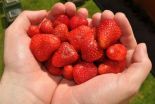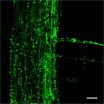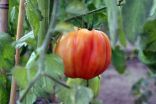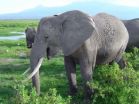Unexpected variation in immune genes poses difficulties for transplantation
2012-08-03
(Press-News.org) Human HLA genes – the genes that allow our immune system to tell the difference between our own cells and foreign invaders – are evolving much more rapidly than previously thought, according to an article online on August 3rd in Trends in Genetics. The resulting degree of variation improves our ability to fight off disease, but could also present challenges to current worldwide efforts aimed at identifying potential donors for patients undergoing stem cell transplantation.
"This new work makes clear the daunting and near hopeless challenge of keeping track of the continuous output from the HLA mutational spigot," says first author William Klitz, from the University of California, Berkeley.
HLA proteins sit at the surface of human cells. Every individual has a specific HLA on the surface of their cells and these proteins effectively act as an identification card. Any other cells that have the same HLA on the outside are recognized as 'self'; foreign particles like bacteria or viruses are identified as invaders and the immune system kicks in to remove them. The same system that helps us fight off germs makes organ or stem cell transplantation difficult. Our bodies treat transplanted tissue as foreign and reject it. Unless, however, the patient and the donor share the same HLA genes. As a result, worldwide efforts are underway to identify all possible HLA variants, in the hopes of more effectively matching patients with potential donors.
The difficulty is that within the human population, HLA genes are mutating rapidly and Klitz estimates that more than a million variants exist in the current population. Trying to identify all the variants will be nearly impossible and ultimately pointless, according to Klitz, because of how quickly these genes are evolving. This rapid evolution is a boon in some ways because it means that, at the population level, our immune systems are getting better at fighting off pathogens. For transplant recipients, however, the most likely implication is that the best chance for a match will be found in first-degree relatives rather than in a worldwide search for donors.
INFORMATION:
Klitz et al.: "New reservoirs of HLA alleles: Pools of rare variants enhance immune defense"
William Klitz, School of Public Health, University of California, Berkeley, CA, USA
Philip Hedrick, School of Life Sciences, Arizona State University, Tempe, AZ, USA
Ed Louis, Centre for Genetics and Genomics, University of Nottingham, UK
ELSE PRESS RELEASES FROM THIS DATE:
2012-08-03
An experiment has shown that strawberry extract added to skin cell cultures acts as a protector against ultraviolet radiation as well as increasing its viability and reducing damage to DNA. Developed by a team of Italian and Spanish researchers, the study opens the door to the creation of photoprotective cream made from strawberries.
"We have verified the protecting effect of strawberry extract against damage to skins cells caused by UVA rays," as explained to SINC by Maurizio Battino, researcher at the Università Politecnica delle Marche in Italy and lead author of the ...
2012-08-03
VIDEO:
Scientists at EMBL have combined the power of two kinds of microscope to produce a three-dimensional movie of how cells ‘swallow’ nutrients and other molecules by engulfing them. The study...
Click here for more information.
Scientists at the European Molecular Biology Laboratory (EMBL) in Heidelberg, Germany, have combined the power of two kinds of microscope to produce a 3-dimensional movie of how cells 'swallow' nutrients and other molecules by engulfing them. The ...
2012-08-03
This press release is available in German.Soil is the most species-rich microbial ecosystem in the world. From this incredible diversity, plants specifically choose certain species, give them access to the root and so host a unique, carefully selected bacterial community from which they then benefit in a variety of ways. To achieve this, the plant's immune system must be able to tell which of these bacteria are friends and which foes. Researchers from the Max Planck Institute for Plant Breeding Research in Cologne and the Max Planck Institute for Marine Microbiology in ...
2012-08-03
This press release is available in German.Tomato breeders scored a coup several years ago when they identified tomatoes with a genetic defect that made the fruits mature very slowly, even under the influence of the phytohormone ethylene. Traders and growers were delighted as it gave them more time to transport the crop, initially still green, from where it was harvested to where it would be sold. At the stores, the tomatoes could then be treated with ethylene to bring them to maturity. Other fruits, like peppers, grapes and strawberries, generally do not mature after picking; ...
2012-08-03
Elephants can communicate using very low frequency sounds, with pitches below the range of human hearing. These low-frequency sounds, termed "infrasounds", can travel several kilometers, and provide elephants with a "private" communication channel that plays an important role in elephants' complex social life. Their frequencies are as low as the lowest notes of a pipe organ.
Although the sounds themselves have been studied for many years, it has remained unclear exactly how elephant infrasounds are made. One possibility, favored by some scientists, is that the elephants ...
2012-08-03
This press release is available in German.Chlorinated biphenyls (PCBs) are a group of substances for which the 2012 List of MAK and BAT Values submitted by the Senate Commission for the Investigation of Health Hazards of Chemical Compounds in the Work Area of the Deutsche Forschungsgemeinschaft (DFG, German Research Foundation) specifies new, and in this case, significantly lower values than previously recommended. The current list, which was presented to the German Federal Minister of Labour and Social Affairs as in every year, and which is the basis for legislation on ...
2012-08-03
Contact: Tsueyling Yong
sciytl@nus.edu.sg
65-651-67874
Carolyn Fong
Carolyn@nus.edu.sg
65-6516-5399
National University of Singapore
NUS researchers identify a novel double-stranded DNA structure
Researchers' findings address a scientific debate that had lasted for 16 years over the existence of a double-stranded DNA structure
Double-stranded DNA has often been described as a right-handed helical structure, known as B-DNA. To perform its multiple functions, double-stranded DNA has multiple structures depending on conditions. For example, the melted DNA ...
2012-08-03
COLUMBUS, Ohio - New research adds to the growing body of evidence suggesting that there's a link between allergies and reduced risk of a serious type of cancer that starts in the brain. This study suggests the reduced risk is stronger among women than men, although men with certain allergy profiles also have a lower tumor risk.
The study also strengthens scientists' belief that something about having allergies or a related factor lowers the risk for this cancer. Because these tumors, called glioma, have the potential to suppress the immune system to allow them to grow, ...
2012-08-03
Acute liver failure is a life-threatening disease, characterized by a sudden, massive death of liver cells. Unfortunately, few treatment options exist, especially for advanced-stage liver failure. As a last resort a liver transplant may be the only remaining option. Now the physician Dr. Junfeng An of the Max Delbrück Center for Molecular Medicine (MDC) Berlin-Buch and Dr. Stefan Donath, a specialist in internal medicine and cardiology, also of the MDC and Helios Klinikum Berlin-Buch, have developed a new treatment approach based on a mouse model. In their current study ...
2012-08-03
Single particles of light, also known as photons, have been produced and implemented into a quantum key distribution (QKD) link, paving the way for unbreakable communication networks.
The results of the experiment, undertaken by a close collaboration of researchers based in Wuerzburg, Munich and Stuttgart, have been published today, Thursday 2 August, in the Institute of Physics and German Physical Society's New Journal of Physics.
The single photons were produced using two devices made of semiconductor nanostructures that emitted a photon each time they were excited ...
LAST 30 PRESS RELEASES:
[Press-News.org] Unexpected variation in immune genes poses difficulties for transplantation




